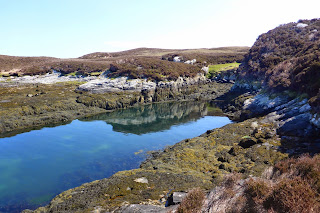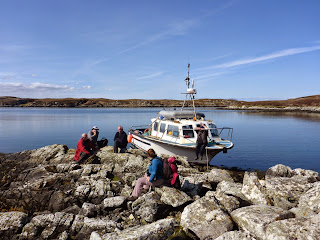 |
| Viola tricolor on sand dunes Image: G. Hall |
To complete our coverage of this year's recording in the Outer Hebrides, I asked Dr Geoffrey Hall, VC Recorder for Leicestershire (VC55) to send us an account of his week on North Uist and to tell us how botanising in the Outer Hebrides compares with botanising in the English Midlands. Here is Geoffrey's account:
"Disembarking from the ferry at Lochboisdale, the drive to
the house we will be staying in for a week crosses moorland, picturesque
fishing villages, small settlements of modern houses with ruins of more ancient
dwellings nearby and white, sandy beaches of a perfection found only in holiday
brochures.
 |
| Some of the team: Stephen, Beth, Mary & Paul (l to r) Image: G. Hall |
"Accompanying Paul this week are Stephen, the recorder for North Ebudes, Mary and David from France and Beth, who’s a student at Kew. We’re soon out recording; the first day’s rain curtailed our efforts, but three hours later we had a respectable species list for some inland grassland, heath and marsh and a good introduction to Hebridean weather.
"Over the following days, recording trips to sand dunes,
coastal marshes and heather-clad hills, and boat trip to the uninhabited island
of Wiay produce more species lists and a better knowledge of the flora and of the
terrain.
 |
| Botanising at Aird a Mhorain Image: G. Hall |
"The open access to land in Scotland contrasts with the
private, fenced-off, policed lowlands. Recording is a lot easier, and the
anxiety of being “where you shouldn’t be” rapidly subsides. Deer fences provide
a substantial obstacle, and unforeseen bog pools, hidden creeks in saltmarsh
and patches of oozing, welly-thieving marsh make the going slow and treacherous
at times.
 |
| Neottia cordata on North Uist Image: G. Hall |
"In some ways, the flat, open landscapes resemble the vast
fields of lowlands agri-business, and both moorlands and islands can be as
species-poor, if numbers alone are considered. But I wish I could find a
handful of the species I see here back home, and these lands still retain the
wildness lost from nearly all of the lowlands. And there is a lot of water – so
many pools and creeks and marshes and bogs; it is painful to be reminded how
much of the lowlands has been drained for agriculture and recreation and how
much wetland habitat has been lost.
 |
| Stunning scenery on North Uist Image: G. Hall |
 |
| Waiting for the return ferry (in Hebridean sunshine!) Image: G. Hall |
"The company of other botanists is always good, swapping tips, experience and ideas, and Paul’s and Stephen’s skills in vegetative identification are highly developed, although they modestly claim that this is necessary when the recording season is so short.
"Long days are followed by evenings finishing off the day’s identifications and watching Paul press dandelions, which is much more interesting and informative than watching television. Producers of reality TV shows have missed a trick there".
Thanks to Geoffrey for this account - and you can see a photo of Geoffrey in his usual habitat on the back of the April issue of BSBI News, where he's taking part in the New Year Plant Hunt in VC55!
No comments:
Post a Comment
Please leave a comment!